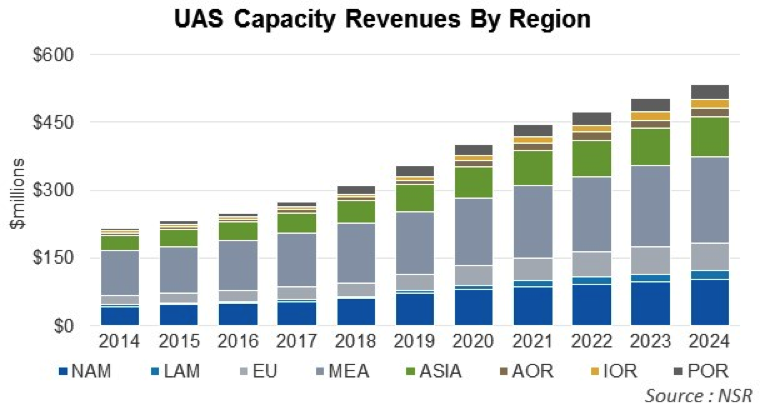A New UAS Paradigm
Feb 8th, 2016
by Prateep Basu, NSR
Unmanned Aerial Systems (UAS) have been utilized for more than
three decades, but their diversity increased only recently, with
explosive growth in small UAS (sUAS) sector. The impact of these
sUAS on satellite services such as Communications and Earth
Observation is difficult to assess, and more so with increasing
technological sophistication in both satellites and UAS.

UAS Industry
Value Pyramid by Airframe Type
In NSR’s UAS Satcom & Imaging Markets,
2nd Edition, UAS markets were analyzed and two segments
were assessed: UAS for Satcom and UAS for Imaging. With mainstream
media focusing on these UAS and other High Altitude Platforms (HAPs)
due to the involvement of tech-giants like Google and Facebook (who
want to provide Internet to the unconnected), along with a
booming sUAS market that has seen acquisitions and investments by
established companies like Intel and Amazon,
NSR believes the UAS industry will be an
externality for satellite industry growth.
UAS Helps Satcom Markets
HALE and MALE UAS like the Global Hawk
and Reapers use Satcom Common Data Links (CDL) for Beyond
Line-Of-Sight (BLOS) communications, and have been a steady source
of revenues for GEO communication satellite operators. However, with
payloads such as SAR, EO/IR
cameras, and applications like full-motion video, bandwidth needs of
UAS have risen tremendously, though the airframe designs haven’t
evolved to take advantage of HTS services yet.
The usage of inclined satellite capacity, especially over regions
where demand is high (like Africa and the Middle-East) has
alleviated costs for the U.S. DoD, which operates the largest fleet
of such UAS. But, NSR
expects a transition to GEO-HTS for these UAS from the mostly FSS
Ku-band equipment,
and in particular to GEO-HTS Ku-band due to the easier retrofits
required. Apart from lower
cost/bit and more bandwidth, GEO-HTS is naturally resilient to
signal jamming as there are multiple beams that need to be jammed,
and that too from within an HTS beam’s coverage area, which is only
a few hundred kilometers wide, making it an attractive proposition
for carrying UAS. Additionally, the advancements in low profile,
bandwidth efficient, and lightweight electronically steered
antennas, combined with the next-generation of satellite modems,
will bring about paradigm shifts in the way UAS are operated.
NSR expects satellite
capacity to UAS revenues to grow to $534 million by 2024, at a CAGR
of 9.4%, largely driven by such changes in UAS operations on Satcom.

UAS Imaging Competes with
Satellite
NSR analyzed the sUAS sector imaging
applications market and noted
opportunity in this industry lies in the
software and services,
which even the industry leader DJI understands by launching its
operating system. The biggest
contribution of this upcoming sUAS industry has been the integration
of technologies, and the rate at
which its refresh puts Moore’s law in the backseat. Recently,
Precision Hawk, Verizon, Digital Globe, and Harris announced
completion of phase 1 testing of an UAS airspace management system,
utilizing Digital Globe’s high-resolution Earth images, Verizon’s
LTE network, and Harris’ satellite-based surveillance (ADS-B) for
safe UAS operations in civilian airspace.
Such seamless integration and
commercialization of satellite and terrestrial technology opens the
gates for a multitude of applications,
specifically those related to Internet of
Things (IoT), by using the UAV as a sensor.
In the same UAS report, NSR found that photogrammetry
applications (like creating a 3D point cloud or ortho-mosaics) have
advanced rapidly, and the turnaround time for image processing has
decreased, which reduces
the competitive advantages of satellite-based Earth imaging.
However, cost of sUAS imaging can be prohibitive for large corridor
mapping, and NSR sees a mixed
approach being gradually taken by both sUAS and satellite-EO
industry, with image fusion
creating layered maps for vertical markets such as agriculture,
energy, and resource management.
Thus, sUAS imaging can be expected to push the satellite
industry’s penetration in new markets, but also act as a pull for
its growth due to the competing nature of the technology.
Bottom Line
UAS have revolutionized the way wars
are fought, and now sUAS are commoditizing imaging and consumer data
analytics. Some have touted this decade as “the one” for UAS, given
explosive growth in all types of airframes, avionics, and associated
software. As the fastest growing sector in aerospace,
NSR expects
the UAS segment to act both as a
‘push’ and a ‘pull’ for the satellite industry over the period of
time, with Satcom for UAS
generating the bulk of the revenues and sUAS imaging leading the
innovation on the technological front.